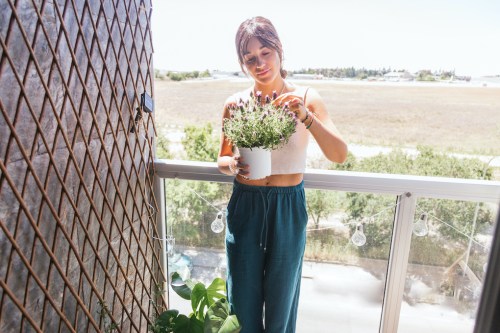Our editors independently select these products. Making a purchase through our links may earn Well+Good a commission
With its soothing smell, calming color, and yes, distinctly floral taste (use it wisely, folks), it’s easy to see why lavender is one of the most popular plants in homes, gardens, and restaurants. What’s harder to grasp? Proper lavender plant care. There is a science to keeping this perennial favorite happy and healthy. That said, it’s nothing you can’t handle with the pro tips below.
Native to the Mediterranean, lavender (or Lavandula) is now found in a wide range of climates and several varietals, which means you can find one that’s best-suited to your environ (as well as different colors, flower types, and sizes). And there’s really no shortage of uses for this multitalented herb, also known as the plant of peace for its stress-reducing properties.
As an essential oil, it can be used to care for your skin and hair. And when it comes to flower arranging, it’s an excellent accent to add to any bouquet. You can also dry it and make a sachet to scent your clothing drawers, or harvest some to flavor ice cream. Just saying, you’ve got options when it comes to how to work with this herb.
While harvesting (and subsequently using) your lavender may be the most rewarding part of lavender plant care, the business of ensuring that this perennial blooms year after year is a critical part of the process, too. All in all, once you’ve established your lavender, the plant should be relatively self-sustaining. And even if your thumb isn’t the greenest, following these simple tips should help you keep your lavender thriving.
5 key lavender plant care tips and tricks
1. Lavender plants do best in direct sunlight and dry heat
The hot sun and relatively infrequent rain that’s key to the Mediterranean’s arid climate is the ideal condition for your potted lavender too—even if you don’t live in Greece. Lavender needs a good eight hours of direct sunlight every day.
2. Only water it about once every two weeks
Like many other plants, lavender is not a fan of being overwatered, so only give yours a good soak when the soil up to your first knuckle is bone dry when you stick your finger into it. And if it’s potted, make sure the vessel has plenty of drainage.
3. Lavender likes soil with a neutral pH level.
Most experts recommend a soil pH of between 6.7 and 7.3 for lavender, which is about the pH level of most potting soil, unless otherwise indicated—but it’s worth asking at the nursery or plant story where you pick up your seeds or starter plant. You can also check the pH level of your soil with a test kit or a soil meter.
4. Select the right species of lavender for your climate
While most lavender abides by the same rules (lots of sun, not too much water), there are, of course, different species of lavender that have different tolerances for various conditions.
Take English lavender, which is most common among North American growers. It’s one of the more hardy species, and as such, it’s able to withstand the cold a bit better than other species. That said, you’ll still want to make sure that they’re covered or sheltered during the winter if they’re outside and consider bringing the plant inside during the cooler months.
On the other hand, if you’re living in humid heat, you may want to opt for Spanish or French lavender plants, which tend to be better suited to more moisture.
5. Prune (i.e. cut) your lavender after it blooms
This is especially important if you find that the stems are getting woody. If that’s the case, cut the plant back by about half its height to encourage new growth and more flowers for the next go-around.
Oh hi! You look like someone who loves free workouts, discounts for cult-fave wellness brands, and exclusive Well+Good content. Sign up for Well+, our online community of wellness insiders, and unlock your rewards instantly.
Sign Up for Our Daily Newsletter
Get all the latest in wellness, trends, food, fitness, beauty, and more delivered right to your inbox.
Got it, you've been added to our email list.











